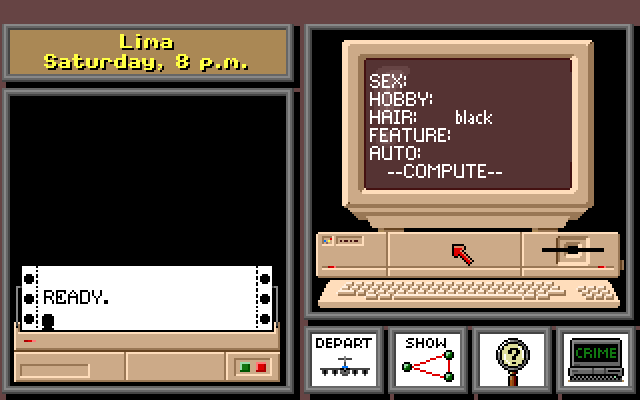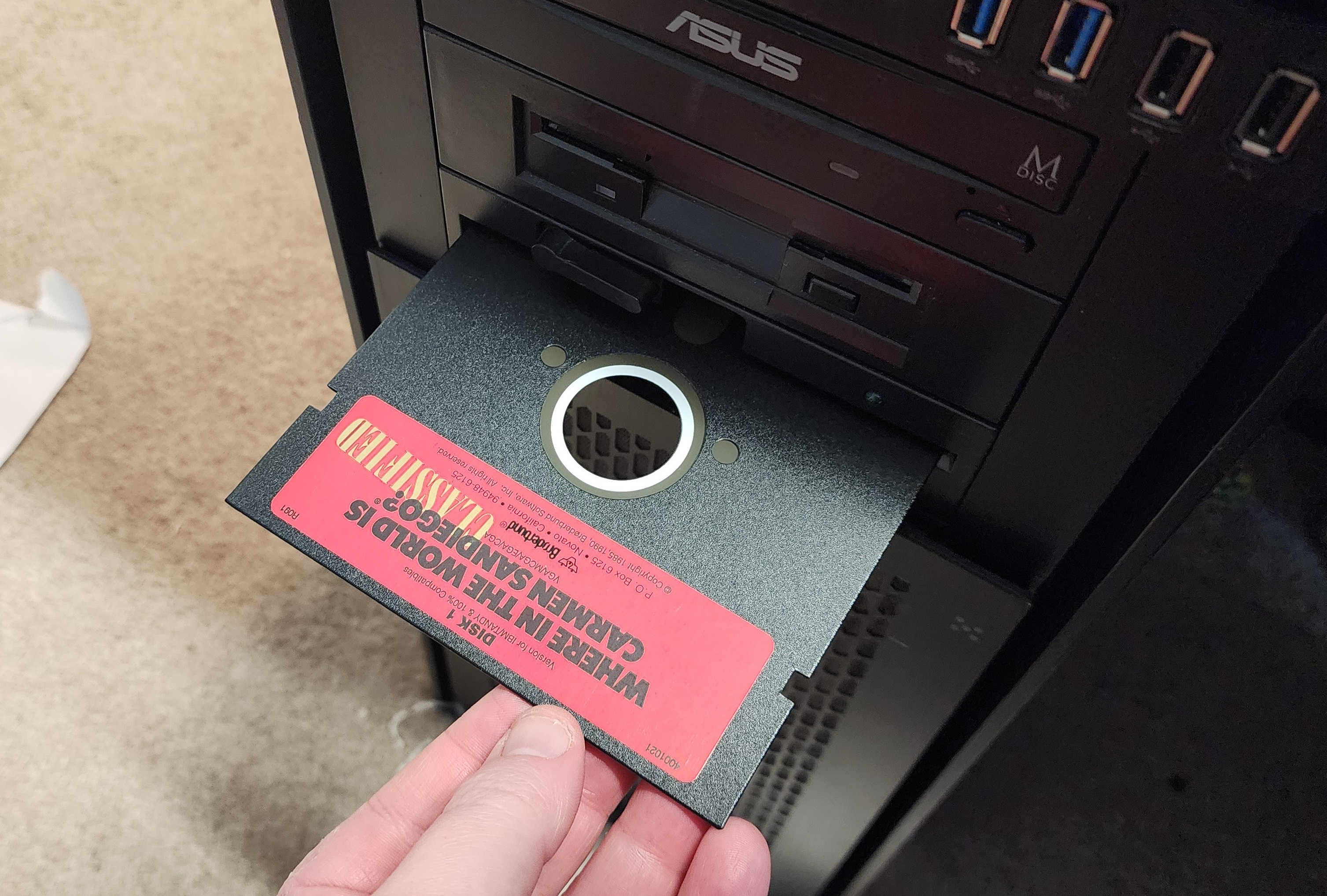tandy put their sound chip on the 1A interrupt?
-
ooh, timing NOPs. Someone figured that PCs wouldn't get any faster after 1990
I got my floppy copy in the mail, I just need to image it.
Fun fact from the box: It has a letter from the player character to their cousin, and I believe this is the only place in the game and associated media that they name your character.
It's Dale.
-
I got my floppy copy in the mail, I just need to image it.
Fun fact from the box: It has a letter from the player character to their cousin, and I believe this is the only place in the game and associated media that they name your character.
It's Dale.
I also discovered that in the Amiga port, they redrew the crime computer to make it clearly an amiga. Cute!

-
I also discovered that in the Amiga port, they redrew the crime computer to make it clearly an amiga. Cute!

Imaged my original disks. Two 360kb 5.25" disks.
They're laid out like this:
Disk 1:
CARMEN.EXE
CARMEN.DAT
Disk 2:
CITIES.DAT
MIDISND.DAT
DIGISND.DAT -
Imaged my original disks. Two 360kb 5.25" disks.
They're laid out like this:
Disk 1:
CARMEN.EXE
CARMEN.DAT
Disk 2:
CITIES.DAT
MIDISND.DAT
DIGISND.DATFinally, we know the answer to the age-old question of Where in the World is Carmen Sandiego?
The answer is "My floppy drive"

-
Finally, we know the answer to the age-old question of Where in the World is Carmen Sandiego?
The answer is "My floppy drive"

it has been 0 days since foone has foolishly tried to hack a decompression algorithm.
-
it has been 0 days since foone has foolishly tried to hack a decompression algorithm.
well my "ignore the problem" solution of using bochscpu to embed a 16bit x86 emulator has failed. it's somehow broken and it's broken in the rust library or C core, not the python, and I really don't want to have to deal with debugging this.
time to switch to a completely different x86 emulator? PROBABLY!
-
well my "ignore the problem" solution of using bochscpu to embed a 16bit x86 emulator has failed. it's somehow broken and it's broken in the rust library or C core, not the python, and I really don't want to have to deal with debugging this.
time to switch to a completely different x86 emulator? PROBABLY!
unicorn has great documentation.
at least I assume it would be great, if it existed
-
unicorn has great documentation.
at least I assume it would be great, if it existed
x86 16bit segmentation and regular expressions:
BECAUSE FUCK IT
-
x86 16bit segmentation and regular expressions:
BECAUSE FUCK IT
I'm implementing unicorn as an x86 emulator to do the decompression, but I'm single-stepping the processor and I'm aiding debugging by showing what instruction I'm on.
but instead of having to set up an x86 disassembly engine, I'm just parsing a plain text ghidra dump of the disassembly. I'm parsing it with regexes
-
I'm implementing unicorn as an x86 emulator to do the decompression, but I'm single-stepping the processor and I'm aiding debugging by showing what instruction I'm on.
but instead of having to set up an x86 disassembly engine, I'm just parsing a plain text ghidra dump of the disassembly. I'm parsing it with regexes
it's too bad python's ctypes doesn't support 16-bit x86. it'd be handy right now
-
it's too bad python's ctypes doesn't support 16-bit x86. it'd be handy right now
my latest bad idea: DUMBPATCH.
to avoid the complexity of generating functions and mapping them into the address space of the emulated PC, I instead designed a simple syntax:
a 16bit segmented address plus a number. that function is emulated as if it returned that number in AX. There are no other options. I suspect I'll be able to emulate up to 80% of complex subfunctions with this one bit of functionality
-
my latest bad idea: DUMBPATCH.
to avoid the complexity of generating functions and mapping them into the address space of the emulated PC, I instead designed a simple syntax:
a 16bit segmented address plus a number. that function is emulated as if it returned that number in AX. There are no other options. I suspect I'll be able to emulate up to 80% of complex subfunctions with this one bit of functionality
I need this because the decompression routine I'm emulating isn't entirely standalone: it calls malloc() at the beginning and free() at the end
so I'm replacing malloc() with a static value and free() with a return value no one will check
-
I need this because the decompression routine I'm emulating isn't entirely standalone: it calls malloc() at the beginning and free() at the end
so I'm replacing malloc() with a static value and free() with a return value no one will check
ideally I should be able to patch arbitrary python in there and do some kind of interop to return values to python
but that's hard. and way easier unflexible thing this is 80% of what I need that for
-
ideally I should be able to patch arbitrary python in there and do some kind of interop to return values to python
but that's hard. and way easier unflexible thing this is 80% of what I need that for
I forgot about callee cleanup. fucking stdcall is callee cleanup. I can't have a generic int blah(){return 0x1234;} function because it needs to know how many words of arguments were pushed.
-
I forgot about callee cleanup. fucking stdcall is callee cleanup. I can't have a generic int blah(){return 0x1234;} function because it needs to know how many words of arguments were pushed.
RELOCATIONS!!!! *shakes fist at sky*
-
RELOCATIONS!!!! *shakes fist at sky*
I took a look at the 1985 version to see if it had any other graphics command line options (it doesn't), but I did discover in passing that it uses a different pronoun system than the 1990 Enhanced version!
-
I took a look at the 1985 version to see if it had any other graphics command line options (it doesn't), but I did discover in passing that it uses a different pronoun system than the 1990 Enhanced version!
It uses @0 for "He/She", @1 for "he/she", and @2 for "his/her".
-
It uses @0 for "He/She", @1 for "he/she", and @2 for "his/her".
hacking a computer system by changing my pronouns to they/them so that it'll use up more memory composing strings referring to me and overflow the buffer
-
hacking a computer system by changing my pronouns to they/them so that it'll use up more memory composing strings referring to me and overflow the buffer
Where in the World is Carmen Sandiego? (1985) has an invert-y-axis option for the joystick, just in case you want to use flight simulator controls to navigate a menu
-
Where in the World is Carmen Sandiego? (1985) has an invert-y-axis option for the joystick, just in case you want to use flight simulator controls to navigate a menu
back on hacking Enhanced, DOS, 1990.
My best guess is that this game has between 4-6 compression algorithms, depending on how you count them. Possibly more are hidden in the bowels of this program.